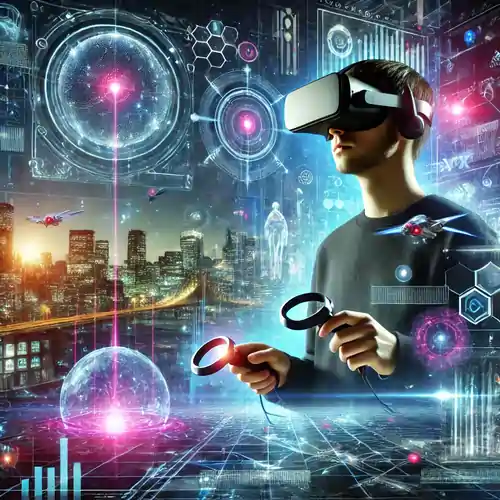Revealing the developments in Virtual Rreality
2.0
Starting off
From its first experimental stages, virtual reality (VR) has evolved much to
become a prevalent technology changing several sectors. Rapid improvements in
VR technology are quickening the shift into the next generation of immersive
events. The development of nextgeneration virtual reality is stretching the
limits of humancomputer dialogue and delivering improved realism, ease, and
functional capabilities.
Rising virtual reality applications, VR software developments, and augmented
reality incorporation among the most recent trends, developments, and
inventions in VR are discussed in this piece. VR 2.0 is transforming the future
of digital experiences whether it is education, health care, games, or
business.
The Evolvement of
Virtual Reality Technology
The virtual reality scene has changed noticeably in the past few years. VR
started it off on clunky hardware with little interactivity. Nowadays we have
lightweight wireless headsets with highdefinition screens, realtime tracking,
and improved motion control. Haptic feedback, eye tracking, and AIdriven
improvements have helped to provide more gripping and lifelike virtual
experiences.
Furthermore, VR development trends have changed toward independent headsets
that remove the requirement for outside computing devices, thus making VR more
consumerfriendly. Virtual reality advancements are being introduced by
businesses including Meta, Sony, and Apple alongside devices with better
ergonomics, longer battery life, and sophisticated spatial audio.
Augmented Reality Integration in Virtual Reality
Version 2.0
Augmented reality integration is one of the major improvements in
nextgeneration virtual reality. ARdriven VR technology facilitates more natural
interaction between digital items and actual surroundings by fusing the
physical and online systems. Called mixed reality (MR), this hybrid solution is
gaining ground in fields such training simulations, architecture, and remote
work technology.
Latest VR headsets feature AR overlays, for example, to improve productivity,
team work, and navigation. Using AR integration in gaming lets players interact
with digital content in their physical environment, thereby producing more
vivid and interactive immersive experiences.
Increasing usages of virtual reality
No longer restricted to games, VR is transforming many industries.
Among the
most hopeful uses of virtual reality are:
1. Healthcare and Therapy
Virtual reality can assist with pain management, psychotherapy for mental health, and medical education in healthcare. Before actually conducting physical operations, surgeons are using virtual reality for accuracybased simulations.
2. Education and Training:
Skillbased training courses, virtual classrooms, immersive historical activities are changing conventional learning techniques.
3. Workplace Collaboration
Virtual Reality meeting areas and digital workstations offer staff working remotely interactive settings to improve teamwork and output.
4. Ecommerce and Retail
Before buying:
virtual showrooms enable customers to see goods in a threedimensional setting.
5. Real Estate and Architecture:
Potential buyers can virtually visit properties, whereas architects use VR to see projects prior to breaking ground.
Main
Virtual Reality Evolution Trends
The most recent virtual reality advancements spotlight the industry's drive
toward more realistic, effective, and userfriendly solutions. Among the more
important trends are:
• Wireless and Cloud-Based VR
Eliminating cables and using cloud technology to stream VR content increases mobility and accessibility.
• AI-Driven Interactions
Artificial intelligence is
enhancing nonplayable character interactions, forecasting analytics, and
content suggestions in virtual reality.
• Social VR
Platforms such as Horizon
Worlds and VR Chat are changing social contacts in digital surroundings,
therefore making online communication closer to real life.
• Haptic and Sensory Feedback
Advanced gloves and bodysuits with sensory feedback enable real-time haptic feedback, so enhancing the artificial scene's realism.
• Sustainable and
Eco-Friendly VR
To minimize environmental effects, developers are working on sustainable products and energyefficient virtual reality equipment.
Progress in virtual
reality program development
VR software development has been vital in improving virtual experiences along
with hardware evolution. Flightbased rendering is allowing effortless access to
topnotch VR content without needing costly computers, while game engines such
as Unity and Unreal Engine 5 are driving photorealistic graphics.
Moreover, eyetracking technology in contemporary VR systems enables foveated
rendering, which enhances the performance and visual fidelity by concentrating
on regions the user is looking at and so maximizing processing power.
Furthermore, artificial intelligencedriven adaptive learning in virtual reality
apps is customizing training modules depending on user progress and behavior.
Innovational virtual shaping
the future
Virtual reality advances in the future will be ready to help VR 2.0 get more
mainstream. Creating lightweight VR glasses, ARcompatible braincomputer
interfaces, and photorealistic avatars is laying the path for more profound
digital immersion. Latency problems in VR will disappear as edge computing and
5G develop, hence enabling realtime, highquality VR interactions.
One of the most awaited developments is the application of blockchain in VR to
enable virtual assets to be securely digitally owned. The metaverse, where
users can buy, sell, and trade virtual goods with verified ownership, is
especially affected by this.
Updates on VR industry
and market growth
The expected total virtual reality market value of more than $100 billion by
2030 indicates encouraging development in the VR sector. Businesses are
actively spending on research and development; rising availability of lowcost
VR options is driving broad adoption. Rising demand for experienced VR
developers is also opening fresh job possibilities in VR content creation,
software engineering, and UX design.
Finally
Virtual reality is going through an
unparalleled change;nextgeneration virtual reality is changing our interactions
in digital spaces. The convergence of cloud computing with AR, AI, is producing
unmatched immersive experiences and broadening companies' use of virtual
reality.
Unlimited possibilities for VR 2.0 abound as virtual reality inventions and
constant developments in VR technology combine. Whether in business,
healthcare, education, or entertainment, VR is increasingly core to our digital
future. As the technology matures, we should anticipate even more revolutionary
developments that will more clearly meld the virtual and actual worlds.









Write your comment